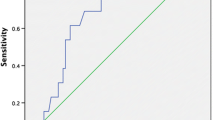Abstract
Objective
To investigate the association of basal testosterone (T) levels with the outcome of in vitro fertilization (IVF) in women with diminished ovarian reserve (DOR).
Methods
Complete clinical data on the first 223 IVF cycles in women with DOR were retrospectively analyzed. The associations of basal follicle stimulating hormone, luteinizing hormone, estradiol, and T levels with ovarian response and IVF outcome were studied.
Results
Basal T levels were significantly different between pregnant and non-pregnant women. However, basal T levels showed no correlation with controlled ovarian hyperstimulation parameters after adjusting for age. The association of basal T levels with pregnancy rate was significant after adjusting for other impact factors. Using receiver operating characteristic (ROC) analysis, the basal T level of 1.115 nmol/L for predicting pregnancy outcome had a sensitivity of 82.80 % and specificity of 58.09 %. The women were divided into two groups based on this value; although the clinical characteristics and ovarian stimulation parameters were similar, the clinical pregnancy (16.18 % (11/68) vs. 40.15 % (53/132), respectively, p = 0.000) and implantation rates (10.07 % (15/149) vs. 22.41 % (65/290), respectively, p = 0.002) were significantly different in the low and high T level groups.
Conclusion
In women with DOR, the basal T level presented a positive association with pregnancy outcome in IVF. The poor reproductive outcome observed in women with lower basal T levels may be due to the decreased implantation rate.
Similar content being viewed by others
References
Broekmans FJ, Kwee J, Hendriks DJ, Mol BW, Lambalk CB. A systematic review of tests predicting ovarian reserve and IVF outcome. Hum Reprod Update. 2006;12:685–718.
Hsu A, Arny M, Knee AB, Bell C, Cook E, Novak AL, et al. Antral follicle count in clinical practice: analyzing clinical relevance. Fertil Steril. 2011;95:474–9.
Burger HG. Androgen production in women. Fertil Steril. 2002;77 Suppl 4:S3–5.
Meldrum DR, Chang RJ, Giudice LC, Balasch J, Barbieri RL. Role of decreased androgens in the ovarian response to stimulation in older women. Fertil Steril. 2013;99:5–11.
Frattarelli JL, Peterson EH. Effect of androgen levels on in vitro fertilization cycles. Fertil Steril. 2004;81:1713–4.
Frattarelli JL, Gerber MD. Basal and cycle androgen levels correlate with in vitro fertilization stimulation parameters but do not predict pregnancy outcome. Fertil Steril. 2006;86:51–7.
Qin Y, Zhao Z, Sun M, Geng L, Che L, Chen ZJ. Association of basal serum testosterone levels with ovarian response and in vitro fertilization outcome. Reprod Biol Endocrinol. 2011;9:9. doi:10.1186/1477-7827-9-9.
Gleicher N, Barad DH. Dehydroepiandrosterone (DHEA) supplementation in diminished ovarian reserve (DOR). Reprod Biol Endocrinol. 2011;9:67. doi:10.1186/1477-7827-9-67.
Kim CH, Howles CM, Lee HA. The effect of transdermal testosterone gel pretreatment on controlled ovarian stimulation and IVF outcome in low responders. Fertil Steril. 2011;95:679–83.
Barad D, Brill H, Gleicher N. Update on the use of dehydroepiandrosterone supplementation among women with diminished ovarian function. J Assist Reprod Genet. 2007;24:629–34.
Gleicher N, Weghofer A, Barad DH. Dehydroepiandrosterone (DHEA) reduces embryo aneuploidy: direct evidence from preimplantation genetic screening (PGS). Reprod Biol Endocrinol. 2010;8:140.
Li M, Schatten H, Sun QY. Androgen receptor’s destiny in mammalian oocytes: a new hypothesis. Mol Hum Reprod. 2009;15:149–54.
Cloke B, Christian M. The role of androgens and the androgen receptor in cycling endometrium. Mol Cell Endocrinol. 2012;358:166–75.
Yang JL, Zhang CP, Li L, Huang L, Ji SY, Lu CL, et al. Testosterone induces redistribution of forkhead box-3a and down-regulation of growth and differentiation factor 9 messenger ribonucleic acid expression at early stage of mouse folliculogenesis. Endocrinology. 2010;151:774–82.
Weil SJ, Vendola K, Zhou J, Adesanya OO, Wang J, Okafor J, et al. Androgen receptor gene expression in the primate ovary: cellular localization, regulation, and functional correlations. J Clin Endocrinol Metab. 1998;83:2479–85.
Cloke B, Huhtinen K, Fusi L, Kajihara T, Yliheikkilä M, Ho KK, et al. The androgen and progesterone receptors regulate distinct gene networks and cellular functions in decidualizing endometrium. Endocrinology. 2008;149:4462–74.
Kajihara T, Tochigi H, Prechapanich J, Uchino S, Itakura A, Brosens JJ, et al. Androgen signaling in decidualizing human endometrial stromal cells enhances resistance to oxidative stress. Fertil Steril. 2012;97:185–91.
Apparao KB, Lovely LP, Gui Y, Lininger RA, Lessey BA. Elevated endometrial androgen receptor expression in women with polycystic ovarian syndrome. Biol Reprod. 2002;66:297–304.
Hu YC, Wang PH, Yeh S, Wang RS, Xie C, Xu Q, et al. Subfertility and defective folliculogenesis in female mice lacking androgen receptor. Proc Natl Acad Sci U S A. 2004;101:11209–14.
Chang C, Lee SO, Wang RS, Yeh S, Chang TM. Androgen receptor (AR) physiological roles in male and female reproductive systems: lessons learned from AR-knockout mice lacking AR in selective cells. Biol Reprod. 2013;89:21.
Acknowledgments
The authors thank Dr. Jianfeng Li for providing scientific advice.
Author information
Authors and Affiliations
Corresponding author
Additional information
Capsule
Low basal serum testosterone leads to poor in vitro fertilization outcome in women with diminished ovarian reserve by decreasing the implantation rate.
Rights and permissions
About this article
Cite this article
Lu, Q., Shen, H., Li, Y. et al. Low testosterone levels in women with diminished ovarian reserve impair embryo implantation rate: a retrospective case-control study. J Assist Reprod Genet 31, 485–491 (2014). https://doi.org/10.1007/s10815-014-0186-3
Received:
Accepted:
Published:
Issue Date:
DOI: https://doi.org/10.1007/s10815-014-0186-3




